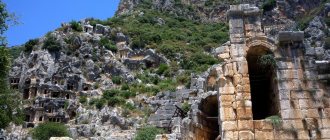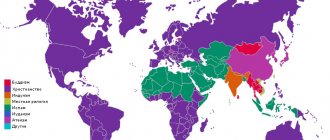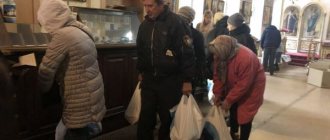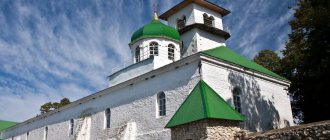Pilgrimage and Christian shrines in Turkey
Modern Turkey is a secular state, more than 90% of which profess the religion of Islam. Despite the fact that today the number of Christians in the country is less than 1%, the Turkish land was once the “cradle” of Christianity, where such important personalities as the Apostle Paul, Nicholas the Wonderworker, Timothy of Ephesus, and Polycarp of Smyrna were born and preached. The Apostle Paul preached and founded churches in the 1st century. The revelation of John the Theologian mentions 7 churches that are located in the modern lands of Turkey: Ephesus, Pergamum, Smyrna (Izmir), Thyatira, Sardis, Laodicea, Philadelphia (Alashehir). On the territory of Turkey there was the state of Byzantium, from where Christianity spread to Rus'. Today, this country is home to numerous Christian shrines, which tourists come to visit from all over the world.
Top 5 Most Visited Christian Places in Turkey.
1. Istanbul
Former Constantinople and capital of the Byzantine Empire. Today, this city has preserved a large number of Christian churches, monasteries and miraculous springs, some of which still perform their functions to this day. The most famous Christian landmark in Istanbul is, of course, the Hagia Sophia, which was built in just 5 years and remained one of the main Christian churches for many years. On the territory of Topkapi Palace, the oldest church of St. Irene, built in the 4th century, has been preserved. In Istanbul there is a functioning convent with a miraculous spring, which, according to legend, was pointed out by the Mother of God herself.
2. Ephesus.
It was a famous city already in the times of Ancient Greece and was an important religious center for the worship of the goddess Artemis, where a temple was erected in her honor, which was considered one of the seven wonders of the world. Later, Ephesus became an important Christian center, where the Apostle Paul preached for several years, John wrote the story of the Son of God and, according to legend, the Virgin Mary lived at the end of her life. Today the House of the Virgin Mary is an important pilgrimage center. The cave near the city of Ephesus is also associated with the legend of the “Seven Sleeping Youths” who slept in it for several centuries.
3. Cappadocia.
This region has many names, one of which is “the pearl of Christianity.” Cappadocia is a unique place in terms of natural landscapes with bizarre mountains and entire underground cities, where early Christians lived, starting from the first century, sermons were preached by the Apostles Paul and Peter. In the 3rd and 4th centuries, the land of Cappadocia became an important Christian center, which with its solitude attracted numerous monks and hermits. More than 50 names of the righteous, saints and martyrs are associated with Cappadocia, among them Gregory the Theologian and Basil the Great. Cappadocia is the birthplace of St. George the Victorious. Today, Cappadocia has preserved a great Christian heritage: many cave churches and monasteries with unique frescoes from the era of early Christianity, secluded hermit cells and amazing underground cities. The Goreme Open Air Museum is a World Heritage Site and is protected by UNESCO.
4. Monastery of Panagea Sumela.
Every year, this inaccessible temple, carved into a rock at an altitude of more than 300 meters above sea level, is visited by numerous pilgrims from around the world. The construction of the monastery began in the 4th century and until 1923 a valuable Christian shrine was kept there - the icon of the Virgin Mary Panagia Sumela, which was painted by St. Luke. Saint Luke is the compiler of one of the existing Gospels, and is also considered the first person to paint an icon and give Christians several miraculous images of the Virgin Mary. According to legend, the image of the Mother of God appeared to the monks Barnabis and Saphronius, who indicated that her image, painted by Saint Luke, should be kept in a hard-to-reach place on Mount Mela. Obeying this command, the monks in 386 founded a monastery on Mount Mela, where over time 3 churches and houses were carved into the rock, designed to receive numerous pilgrims. For many centuries, the monastery remained very revered and enjoyed the patronage of monarchs and even sultans of the Ottoman Empire, but during the First World War it received significant damage, was looted, and wall paintings were destroyed. The monks left the monastery, having previously hidden the icon of Our Lady Panagia Sumela, which in 1923 was found by one of the monks and transferred to Athens. Today the icon is also in Greece. The Panagea Sumela Monastery today cannot boast of the former beauty of its paintings and decorations, but the churches, monastery cells and hotels are available for visiting. The road to the monastery remains difficult to access today - you have to climb numerous steps onto a steep slope, however, pilgrims who have been there describe the sensations of insight and grace from visiting this place.
5. City of Demre, Lycian Myra.
This place is associated with the ministry of St. Nicholas or St. Nicholas the Wonderworker, revered throughout the Christian world. Today the city of Demre is one of the most easily accessible and visited Christian places in Turkey. The Church of St. Nicholas the Wonderworker, as well as his sarcophagus, has been preserved here; sacred services are held in the temple several times a year. The church was first built in the 4th century, but was later subjected to raids and destruction. Wall paintings that date back to the 11th and 12th centuries have survived to this day. The relics of St. Nicholas were taken out in the 11th century and are now kept in Italy. Saint Nicholas is the patron saint of sailors; the miracle of the resurrection of a sailor is attributed to him. According to Catholic tradition, the image of St. Nicholas the Wonderworker is a prototype of Santa Claus, thanks to the legend about helping the poor and secretly giving gifts. Currently, the temple is not active and has the status of a museum.
These places are only a partial list of the Christian heritage in Turkey; in many cities significant places of preaching have been preserved, marked by the visit of the apostles and associated with their activities. The number of pilgrims visiting Turkey is growing every year, and interest in the rich history of this country is growing. Last year, a significant event took place on the territory of Alanya - a new Christian temple was built and opened, which is currently operational and clearly reflects the tolerance and excellent attitude of Turkish citizens towards another culture and religion.
The Society of Russian-speaking Orthodox Believers of Antalya Province has been established in Turkey.
Antalya, November 13, 2021
May 25 this year His Holiness Patriarch Kirill sent the cleric of the Belgorod Metropolis, priest Georgiy Ivanchoglo, to the Republic of Turkey for the spiritual care of Orthodox believers living in the Turkish province of Antalya.
Earlier in Antalya, a group of Orthodox citizens of the Republic of Turkey, led by Oksana Vladimirovna Alykan, began collecting documents for the official registration of the first in the history of the country, the Society of Russian-speaking Orthodox believers of the province of Antalya (Antalyadaki RusçaKonuşan OrtodoksİnançlılarDerneği).
As a result of lengthy coordination with the Ministry of Justice and the Ministry of Culture of Turkey, on August 8 this year. The constituent documents of the Society were drawn up, Patriarchia.ru reports. It unites Russian-speaking Orthodox believers in the Antalya province, which includes the cities of Demre, Kemer, Antalya, Belek, Side, Manavgat, Avsallar, Alanya and Mahmutlar. O.V. became the Chairman of the Society. Alykan.
The newly formed Society is subordinate to the Moscow Patriarchate Office for Foreign Institutions.
Simultaneously with the paperwork, a search was underway for a room in which regular religious services could be held for the residents of Antalya.
November 1 this year official permission was received from the Antalya Governorate and the Security Service to hold regular religious services in a rented premises in the Muratpasa district of Antalya at the address: st. Cumhuriyet 60 (Elmalı, No:, Cumhuriyet Cd. No:60, 07040 Muratpaşa/Antalya).
The website of the Society of Russian-speaking Orthodox Believers of Antalya Province has started working - www.pravantalya.com, and a group has also been formed on the social network Facebook.
* * *
In connection with the decision of the Holy Synod of the Russian Orthodox Church of October 15, 2021 on the impossibility of Eucharistic communion with the Patriarchate of Constantinople due to gross violation of the canons on its part, the Moscow Patriarchate began to receive numerous appeals from Russian-speaking Orthodox believers living in Turkey with a request to organize pastoral care.
By decree of His Holiness Patriarch Kirill of Moscow and All Rus', Priest Georgy Sergeev was sent to the Turkish Republic to perform regular services in the Church of Saints Equal-to-the-Apostles Constantine and Helen, located on the territory of the summer residence of the Consulate General of the Russian Federation in Istanbul, and to organize the care of the Russian-speaking flock in other cities of the country.
On November 11, 2021, Priest Georgy Sergeev celebrated the first Divine Liturgy after his appointment in the Church of Saints Equal-to-the-Apostles Constantine and Helen in Istanbul. Following this, services were held in other cities of Turkey - Ankara, Izmir, Kusadasi, Antalya, Demre, Eskisehir.
On May 25, 2021, the Primate of the Russian Orthodox Church sent the cleric of the Belgorod Metropolis, priest Georgy Ivanchoglo, to the Republic of Turkey, whose tasks include the spiritual care of believers living in the province of Antalya.
Recommendations for visiting the monastery of Panagia Soumela
If you don't have a car, there are three ways to get from Trabzon to Panagia Sumela: by taxi from the parking lot marked "Sumela Manastiri'na" in the southern part of Ataturk Alani; by dolmushi to Sumela Monastery, the final stop of which is located next to the taxi rank, and with a tour that starts at 10.00 and is organized by local travel companies Afacan and Usta. The excursion costs 30 liras per person per seat in the minibus and you will have to pay your own entrance fee.
Aqueduct and staircase of the monastery
A fair distance, frequent landslides on the highway and a stop at a tea shop mean that the round trip usually takes about 2.5 hours. About the same amount will be needed to explore the ruins. If you go by car, then from the intersection of highways 010 and E-97/885 on the coast, 3.5 kilometers east of Trabzon, there are still 43 kilometers left to Panagia Sumela. After 26 kilometers, turn off the E-97/885 highway, which leads to Mačka, onto the road that runs along the Altındere valley.
Entrance to the Sumela Monastery
The entrance to Sumela is of extraordinary beauty. As you rise up, you see thick spruce forests descending towards you and equally dense clouds almost constantly hanging over the local mountains. On rare occasions, you can make out the monastery walls, faded to white, rising above the trees at an altitude of 1200 meters above sea level. The monastery is connected to the valley by a slippery wooden boardwalk (30 minutes walk).
Excursion to the Sumela Monastery
If you're by car, you can try climbing the steep, once paved 3.5-kilometer road (no buses run on it) that rises from the valley to the level of the monastery. The parking lot you can park in is used by a group of local restorers. From here to the monastery is a 10-minute walk. There is a third way through the abandoned chapel, along which you must first drive 1 kilometer along a concrete road, and then along a wooden bridge over the river. Not far from the monastery, this road merges with road number two.
Entrance ticket to the monastery
Hotels and restaurants near the monastery of Panagia Soumela
Kayalar Turistik Dinlenme Tesisleri, 3 kilometers from the monastery ticket office, is an excellent alternative to Trabzon hotels. All rooms in this charming historic building have wood floors, balconies and sinks (and some have en-suite baths), there are several multi-room family rooms and a fish restaurant serving locally farmed trout. The surrounding area of the Panagia Sumela monastery has been declared a national park (entering its territory by car costs 8 liras) with a picnic area, the Cardak snack bar and the Sumela Sosyal Tesisleri restaurant.
Restaurant at the Sumela Monastery
This restaurant cannot be called excellent: it is hampered by chaotic service, high prices and a mandatory 10% tip for service, but it has an excellent location and good cuisine with such national dishes as lakhana sarmas (stuffed young cabbage leaves). The Altındere Valley also has simple but attractive bungalows for €15 per person. Further downstream there are several fish farms, and the Sumela Ciftlik restaurant 2 kilometers behind Machka offers good meze and fish.








